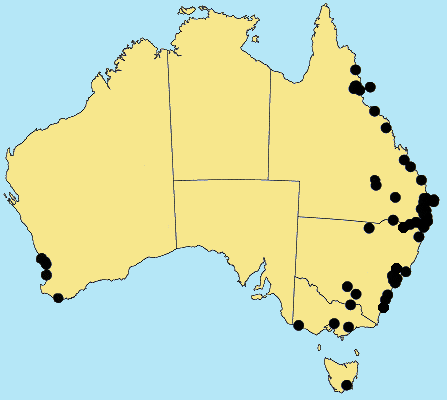Paspalum urvillei* Steud. Syn. Pl.
Glum. 1: 24(1854).
Classification. (GPWG 2001) : Subfamily
Panicoideae. Paniceae.
Type of Basionym or
Protologue Information: Brazil: 1825, J.S.C. Dumont de Urville s.n.
(HT: P; IT: B, CN, US-80035 (fragm.)).
Key references
(books and floras): [1952] C.A.Gardner, Flora of Western Australia 1
Gramineae (242), [2002] D.Sharp & B.K.Simon, AusGrass, Grasses of
Australia, [2002] J.Wheeler, N.Marchant & M.Lewington, Flora of the
South West (425), [2008] S.W.L.Jacobs, R.D.B.Walley & D.J.B.Wheeler, Grasses
of New South Wales (331).
Illustrations:
[2008] S.W.L.Jacobs, R.D.B.Whalley & D.J.B.Wheeler, Grasses of New South
Wales, 4th edn (331).
Habit.
Perennial. Rhizomes present. Stolons absent. Culms erect, 80–250 cm tall, 3–6
-noded. Mid-culm nodes glabrous. Lateral branches simple. Leaf-sheaths glabrous
on surface or hairy. Leaf-sheath auricles present. Ligule an eciliate membrane,
2–9 mm long. Leaf-blades 20–60 cm long, 4–25 mm wide. Leaf-blade surface
smooth, glabrous.
Inflorescence.
Inflorescence compound, a panicle of racemes. Racemes 10–30, appressed, 4–14 cm
long, 3–4 mm wide, bearing 80–140 fertile spikelets on each. Central
inflorescence axis 10–30 cm long.
Spikelets.
Spikelets sessile and pedicelled. Fertile spikelets 2-flowered, the lower
floret barren (rarely male), the upper fertile, comprising 1 basal sterile
florets, comprising 1 fertile floret(s), without rachilla extension, ovate,
dorsally compressed, 1.6–2.8 mm long.
Glumes. Glumes
thinner than fertile lemma. Upper glume ovate, 1.6–2.8 mm long, membranous,
without keels, 3 -nerved. Upper glume surface indumented. Florets. Basal
sterile florets 1, barren, without significant palea. Lemma of lower sterile
floret 100 % of length of spikelet, membranous, 3 -nerved.
Fertile lemma 1.4–2.6
mm long, without keel.
Continental Distribution:
Europe, Africa, Temperate Asia, Tropical Asia, Australasia, Pacific, North
America, and South America.
Australian
Distribution: Western Australia, Northern Territory, Queensland, New South
Wales, Victoria, Tasmania.
Western Australia:
Drummond. Queensland: Cook, Darling Downs, Moreton, North Kennedy, Port
Curtis, South Kennedy, Wide Bay, Leichhardt. New South Wales: North
Coast, Central Coast, Central-Western Slopes, South-Western Slopes. Victoria:
Gippsland Plain, Midlands, Wannon. Tasmania: East Coast.
Notes.
A tall, coarse perennial of little or no economic importance.
Introduced. In
tropical and subtropical rain forests, tropical and subtropical wet sclerophyll
forests, dry sclerophyll forests, and tropical and subtropical sub-humid
woodlands. Flowers Nov.- June.





